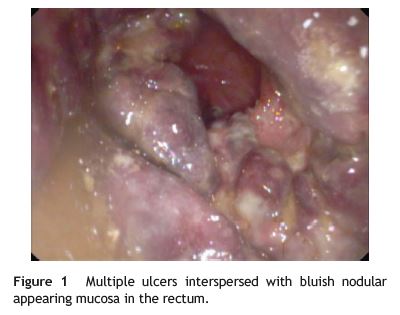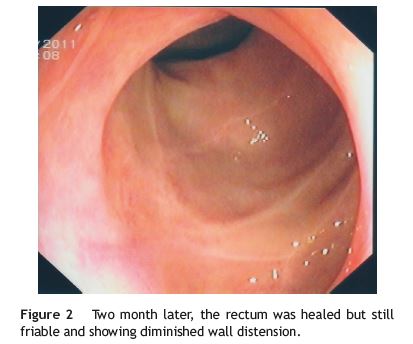Serviços Personalizados
Journal
Artigo
Indicadores
-
 Citado por SciELO
Citado por SciELO -
 Acessos
Acessos
Links relacionados
-
 Similares em
SciELO
Similares em
SciELO
Compartilhar
Jornal Português de Gastrenterologia
versão impressa ISSN 0872-8178
J Port Gastrenterol. vol.20 no.5 Lisboa set. 2013
https://doi.org/10.1016/j.jpg.2012.12.009
ENDOSCOPIC SPOT
Homemade colonic enema: Hot and oily
Enema caseiro: quente e gorduroso
João Dinis Silva a,∗, Miguel Serranob, Vitor Fernandesc
a Gastroenterology Department, Hospital Espírito Santo de Évora EPE, Évora, Portugal
b Gastroenterology Department, Instituto Português de Oncologia de Lisboa, Francisco Gentil, Lisboa, Portugal
c Gastroenterology Department, Hospital Garcia de Orta EPE, Almada, Portugal
* Corresponding author
Case description
A 67-year old woman with a major depressive disorder, urinary bladder incontinence and hypertension was brought to our emergency department with hematochezia and anal pain. Her complaints had begun five days before admission and after she had had a hot water mixed with olive oil enema for the relief of chronic constipation. She self administered and immediately evacuated the hot mixture. Lower abdominal discomfort ensued over the following hours and by the end of the first day, rectal bleeding and severe anal pain had appeared. These complaints worsened with time. On physical examination, she had a tender lower abdomen and an ulcerated lesion on the perianal skin. Her temperature was normal. Laboratory results revealed a white blood count - 11 000 per mm3, hemoglobin - 10.1 g/dL and C-reactive protein - 14 mg/dL (0-0.2 mg/dL). Colonoscopy showed multiple ulcers interspersed with bluish nodular appearing mucosa in the rectum (Fig. 1). Histopathology was consistent with acute inflammation. Intravenous fluid therapy, bowel rest and analgesia were given for recovery. She was discharged on day three. On follow up colonoscopy, two month later, the rectal mucosa appeared healed, still friable with diminished wall distension but without stenotic segments (Fig. 2).


Colonic water enemas constitute a common therapeutic weapon in the battle against constipation. The addition of some products to the enema water aims at increasing its efficacy as a cathartic or as a detoxifier. The deleterious effects that some of these substances can have on the colonic mucosa have been described,1 none involving the use of olive oil. However, in this case, injury was most probably caused by the use of heated water in the enema. The lesions so caused are initially quite symptomatic but generally self-limited and uneventful, rarely requiring surgery.2,3
References
1. Cappel MS. Colonic toxicity of administered drugs and chemicals. Am J Gastroenterol. 2004;99:1175-90. [ Links ]
2. Jones LE, Norris WE. Rectal burn induced by hot coffee enema. Endoscopy. 2010;42:E26. [ Links ]
3. Sashiyama H, Hamahata Y, Matsuo K, Akagi K, Tsutsumi O, Nakajima Y, et al. Rectal burn caused by hot-water coffee enema.Gastrointest Endosc. 2008;68:1008. [ Links ]
Conflicts of interest
The authors have no conflicts of interest to declare.
*Corresponding author
E-mail address: jdinisilva@gmail.com (J. Dinis Silva).
Received 14 September 2012; accepted 12 December 2012













